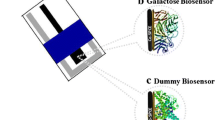Abstract
An amperometric biosensor was developed to estimate galactose in human blood serum. Monolayers of poly(3-hexyl thiophene) were placed on glass plates coated with indium tin oxide formed by dispensing a mixed solution of stearic acid in chloroform on to a water sub-phase. Galactose oxidase was mixed with poly(3-hexyl thiophene)/stearic acid in chloroform and dispensed on to the air-water interface of Langmuir–Blodgett trough. These monolayers were transferred on to glass plates which were used as working electrodes with platinum as a reference electrode. The amperometric galactose biosensor thus fabricated had a linear response from 0.05 to 0.5 g galactose l−1 in blood serum. The normal level in blood is < 0.05 g galactose l−1 in adults and 0–0.2 g galactose l−1 in infants. In case of galactosemia, this increases to above 0.2 g galactose l−1 in infants.
Similar content being viewed by others
References
Croisetière LR, Rouillon R, Carpentier (2001) A simple mediatorless amperometric method using the cyanobacterium Synechococcus leopoliensis for the detection of phytotoxic pollutants. Appl. Microbiol. Biotechnol. 56: 261-264.
Hann RA (1990) Molecular structures and monolayer properties. In: Roberts G, ed. Langmuir-Blodgett Films. New York: Plenum, pp. 17-83.
Petry K, Reichardt J (1998) The fundamental importance of human galactose metabolism: lessons from genetics and biochemistry. Trends Genet. 14: 98-102.
Petty MC (1991) Application of multiplayer films to molecular sensors: some examples of bioengineering at the molecular level. J. Biomed. Eng. 13: 209-214.
Rajendran V, Lrudayaraj J (2002) Detection of glucose, galactose and lactose in milk with a microdialysis-coupled flow injection amperometric sensor. J. Dairy Sci. 85: 1357-1361.
Schumacher D, Vogel J, Lerde LI (1994) Construction and application of enzyme electrode for determination of galactose and galactose containing saccharides. Biosens. Bioelectron. 9: 85-90.
Segal S (2001) In vivo evidence of brain galactitol accumulation in an infant with galactosemia and encephalopathy. J. Pediat. 138: 260-262.
Suzanne LW, Robert R, Jie C, Yager C, Segal S (2002) Metabolism of 13C galactose by lymphoblasts from patients with galactosemia determined by NMR spectroscopy. Mol. Genet. Metabol. 77: 296-303.
Szabo EE, Adanyi N, Varadi M (1996) Application of biosensor for monitoring galactose content. Biosens. Bioelectron. 11: 1051-1058.
Watanbe N, Kawasaki S (1987) Determination of galactose in human plasma by HPLC with electrochemical detection. Biomed. Chromatogr. 2: 95-98.
Wilkins JR (1978) Use of platinum electrodes for the electrochemical detection of bacteria. Appl. Env. Microbiol. 36: 683-687.
Worthington V (1972) Worthington Enzyme Manual. Freehold, NJ: Worthington Biochemical Corporation, pp. 21-22.
Author information
Authors and Affiliations
Rights and permissions
About this article
Cite this article
Sharma, S.K., Singhal, R., Malhotra, B. et al. Biosensor based on Langmuir–Blodgett films of poly(3-hexyl thiophene) for detection of galactose in human blood. Biotechnology Letters 26, 645–647 (2004). https://doi.org/10.1023/B:BILE.0000023023.19651.01
Issue Date:
DOI: https://doi.org/10.1023/B:BILE.0000023023.19651.01




